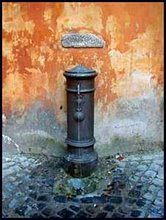Today i want to say goodbye to all of you because i'm going on holiday and this is my last post..until i'll be back! A Night in Rome blog close for just 2 weeks!
Beware...today's topic is really really dirty!! Enjoy and when you are in Rome pay attention on where you are walking! ;-)

A really thorny problem in Rome, during 1700, was the elimination of the urban garbage. Until the 1800 was a common habit, both for the poorest families and for the servitude of the richest ones, to melt the daily domestic garbage leaving itself all along the way, in the square and at the street crossings. Only when the garbage piles became a really big cumulus (a “mondezzaro” according to the lexicon of that age & how is written on the marble plate above!) a little cart reached in order to carry it away, sometimes after weeks!! This situation easily get worse not only due to the fact that the street were cleaned up from the equine excrements only once a week (by the prisoners who, for this reason, were periodically lead in chain to the city) but also to the fact that the so called “ammazzacani”,(ancient version of the modern dogcatcher) to resolve the problem of the wondering dogs and cats attracted by the garbage, used to pull them down using poisoned scraps and leaving the dead animals along the city alleyways! Many were the consequences of this dramatic situation especially from the hygienic & sanitary point of view; first of all, the bad smell that exhaled from the big cumulus of garbage especially during the hottest seasons…
Also in 1700, a century not famous for its hygienic measures, all these situations had really to turn out troublesome for who lived in the palaces near such “garbage collections”!
 Trying to get the situation better, at the end of 1600 appeared, at first on the walls of some important churches (Sant'Agostino, Saint Carl al Corso, Saint Theodore, and many others), some inscriptions which prohibited to accumulate refusals foreseeing pecuniary and corporal penalties for the transgressors. Such a deterrent probably had the hoped effects, because by the half of 1700, especially at street crossing, under the noble palaces, began to being emanates the “editti” to let people know how to behave with garbage. In these “editti” was made prohibition to throw garbage near the palaces making the “mondezzaro”. Such “editti” were emanated by the President of the Roads (a high administrative charge that presided to the order of the city ways) who delegated the Master of the Roads the task to control that the provision was respected.
Trying to get the situation better, at the end of 1600 appeared, at first on the walls of some important churches (Sant'Agostino, Saint Carl al Corso, Saint Theodore, and many others), some inscriptions which prohibited to accumulate refusals foreseeing pecuniary and corporal penalties for the transgressors. Such a deterrent probably had the hoped effects, because by the half of 1700, especially at street crossing, under the noble palaces, began to being emanates the “editti” to let people know how to behave with garbage. In these “editti” was made prohibition to throw garbage near the palaces making the “mondezzaro”. Such “editti” were emanated by the President of the Roads (a high administrative charge that presided to the order of the city ways) who delegated the Master of the Roads the task to control that the provision was respected.The content of all these plates was substantially the same but it was not important because at that time just few people were able to read!
Therefore, between 1717 and 1771, on the walls of the historical center appeared a great number of marble plates bringing the prophetic admonishment: do not soil here! The plates also exposed the penalty previewed in case of remissness to the prohibition: pecuniary punishment, personal capture, corporal pains or excommunication (if you had left garbage near a church!!). Entities and modalities were at the discretion of the President of the Roads. The aim of these multiple endorsements was to hit both the sending and the material executor of the crime: the executor (usually a servant) was usually subject to the corporal pains, while the other (the master) would have had to pay a high fine (“alla pena pecuniaria sia tenuto il padre per li figli e li padroni per li servitori” the father pays for the sons and the master for the servant).
The plates also exposed the penalty previewed in case of remissness to the prohibition: pecuniary punishment, personal capture, corporal pains or excommunication (if you had left garbage near a church!!). Entities and modalities were at the discretion of the President of the Roads. The aim of these multiple endorsements was to hit both the sending and the material executor of the crime: the executor (usually a servant) was usually subject to the corporal pains, while the other (the master) would have had to pay a high fine (“alla pena pecuniaria sia tenuto il padre per li figli e li padroni per li servitori” the father pays for the sons and the master for the servant).Moreover, in order to convince the population to delate the anonymous filthy persons, some “editti” contained the norm that a part of the fine would have been given to the prosecutor, whose name obviously would have remained secret.
The prohibition remained more over a long time until the fall of Papal State (1870); the rigor that the civic administrators put in applying the beautiful endorsements inspired Belli for one of his most famous “ironici sonetti”:
« Per questi editti di sasso, divenuto più nero della scrittura che vi fu incisa, può ancora accadere che qualche fantesca maledica chi non le insegnò l'alfabeto »
Today you can still find in Trastevere, scattered here and there, the modern version (written on a piece of paper) of the ancient marble plates which invite to :
Today you can still find in Trastevere, scattered here and there, the modern version (written on a piece of paper) of the ancient marble plates which invite to :
“please don’t leave garbage here, the apposite baskets are really near!”
(Here is a list of all the marble plates you can find in Rome, there is also one in Piazza della Gensola near our apartments!)
































